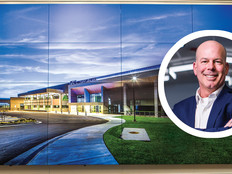How K–12 Schools Tackle Mobility Management
Chris Russo already had his hands full as director of technology for Maine School Administrative District No. 60 in North Berwick, overseeing network resources and managing mobile devices at eight schools and a pair of offices in three towns. Then district leaders decided to merge several administrative positions with those in neighboring Maine School Administrative District No. 35, adding five more schools and two more offices to Russo's responsibilities.
In MSAD 60, "Every student in grades four through 12 has a Chromebook — that's just under 3,000 devices," Russo says. Staff members have two devices each, and K–3 students share 300 tablets. MSAD 35 maintains several carts of devices that are shared by multiple users.
Adding to the challenge of managing all of these devices: distance. "End to end between the two districts is almost an hour's drive," Russo says.
Choosing Carefully
With the convenience of mobility come numerous challenges. As such, "Every organization needs some kind of mobility management strategy," says Richard Absalom, a senior analyst at London-based technology consulting firm Ovum.
Increasingly, Absalom says, he's talking with IT leaders in all markets not just about mobile device management, but also about enterprise mobility management. "Managing the device is really only one part of that," he says. "More and more, vendors are focused on managing applications and data."
Choosing the right management solution means understanding the differences between schools and other organizations, Absalom continues. Schools are more likely than other organizations to deal with a wider range of devices or "a thousand kids who need to use the Wi-Fi network at the same time to access cloud-based apps," for example, he says.
Given those realities, he adds, schools should choose flexible solutions that are as device-agnostic as possible and can prioritize traffic to core apps.
Collapsing the Miles
To get a better handle on the complex mobile environment he oversees, Russo turned to the AirWave network management system from Aruba Networks. "What's cool about AirWave is that you can pull in other, non-Aruba products," he says. "We can manage the network essentially through one interface." This flexibility is crucial for budget-conscious districts, which often must put older gear to work (rather than retire it) to expand access for teachers, staff and students.
Russo runs a fairly open network, but he appreciates that AirWave can identify personally owned devices and route that traffic to specific ports. "We're seeing a dramatic increase in the number of devices on the network — and we're just starting to dig into creating policies based on which device a user has," he says.
AirWave's price also made it a compelling choice, Russo adds, noting that many other systems he evaluated were either too expensive or required yearly licensing fees.
Roughly 1 out of 3 U.S. middle and high school students has access to a school-provided mobile device; 1 out of 4 students in grades 3–5 has similar access.
SOURCE: The New Digital Learning Playbook: Understanding the Spectrum of Students' Activities and Aspirations (Project Tomorrow, 2014)
Tablets and the Cloud
The IT department at Mater Dei High School in Santa Ana, Calif., doesn't face the geographic complexities that Russo's team must manage.
Instead, their biggest challenge is keeping tabs on the school's 2,100-plus students, who, "like all teenagers, want to be on social media," says Technology Support Specialist Arturo Calleros. "It's easy for them to be distracted."
Mater Dei's IT department uses AirWatch's MDM solution to manage the devices and to ensure that they are used solely for educational purposes. Because the solution is cloud-based, "students can no longer download apps, such as games or social media, at home and then just delete them before arriving on campus. Anything they install that they aren't supposed to, we see."
AirWatch takes the app-control aspect of MDM and makes it nearly automatic, with a feature that allows enterprise-level users to build a list of authorized apps. If a student downloads an unauthorized app, Calleros adds,they automatically lose the ability to have Wi-Fi on campus — without direct intervention by the IT team. Access can be restored after a visit to the Tech Hub in the school library.
Beyond the Network
Although an enterprise MDM solution is crucial, it's just as important to consider how devices will be assigned to users, says Patches Hill, technology systems manager for the 15-school Indian River School District in Selbyville, Del.
The district adopted MDM more than two years ago. But that alone isn't a cure-all for a school's IT woes, Hill cautions, noting that the cart-based tablet distribution model at IRSD doesn't always dovetail with its MDM solution. The reason: Most mobile devices are designed for a single user.
A device-agnostic MDM solution will be of continued importance as IRSD explores a shift to one-to-one, Hill continues. "I can't say that every student in our district will be on one version of one device all at one time," he says. Because the district doesn't intend to shift toward a bring-your-own-device model in the near future, network access control will remain critical.
In the end, he says, "The needs of the child should be driving decisions. We should be able, with the technology, to better meet those needs."
Plan Accordingly
Mobility has become pervasive in K–12 environments, but that doesn't mean that a one-size-fits-all approach to network management will suffice. Here's a snapshot of three different solutions.
Maine School Administrative District No. 60 (North Berwick) and No. 35 (Eliot)
- Mobile deployment: Mix of tablets, Chromebooks and notebook computers; one-to-one for the higher grades, shared carts of devices for the lower grades
- Network configuration: Open-access, self-provisioning Wi-Fi network using Aruba Instant wireless access points; Aruba AirWave used to manage devices in three of the schools, with more rollouts planned this summer
Mater Dei High School, Santa Ana, Calif.
- Mobile deployment: One-to-one tablet program for all students, who pay an annual technology use fee
- Network configuration: School-issued tablets run on a student network; students who use a personally owned device for special projects use the public network; staff and faculty use a private network
Indian River School District, Selbyville, Del.
- Mobile deployment: Mix of notebooks and tablets, but considering Chromebooks; currently using cart-based model for most students
- Network configuration: Access-controlled hub-and-spoke; authenticated users are issued an ID and password








